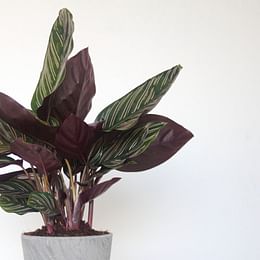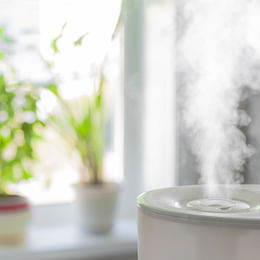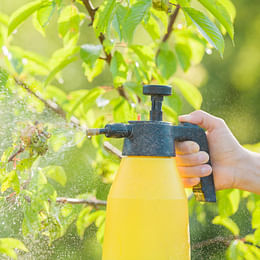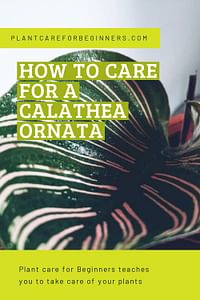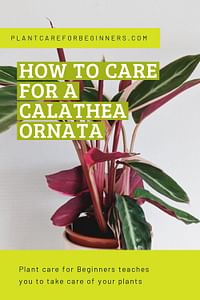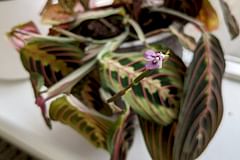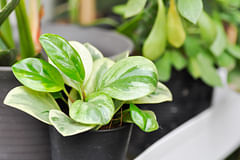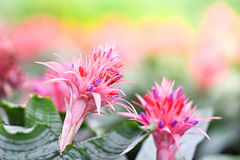How to care for a Calathea Ornata
In this guide, we're going over some tips on how to care for a Calathea Ornata. These plants can be fussy, but once you learn some of the tips and tricks from this post, your plant should be easier to care for.
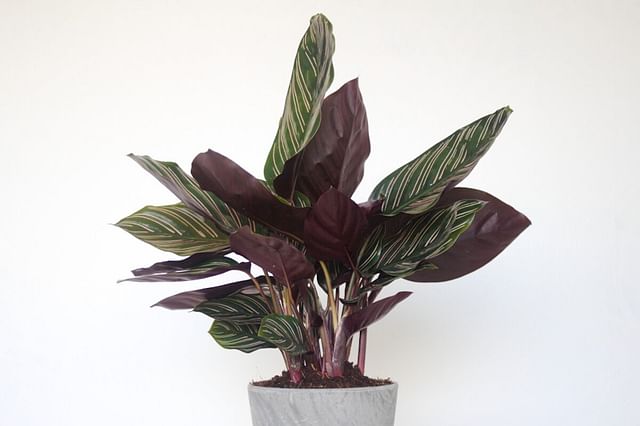
The Calathea Ornata (also called the Calathea Pinstripe or Pinstripe plant) is a beautiful plant with pink stripes on its large green leaves. It's beautiful, but it can be a fussy plant and difficult to care for at times. We all know someone who has struggled to keep a Calathea healthy, let alone alive. So with this guide, we'll look at what you can do to keep these amazing, but stubborn, tropical plants healthy.
In this guide, we'll go over watering needs, preferred soil, light requirements, how and when to fertilize, humidity, common pests, and early signs your plant is struggling. If this plant has been difficult for you in the past, this is the guide for you. After we've gone through all of the steps below, you'll have everything you need to know to keep your Calathea(s) happy.
In this guide, we'll go over these aspects of taking care of a Calathea:
Now, let's get right into it and learn more about your Calathea.
Watering your Calathea
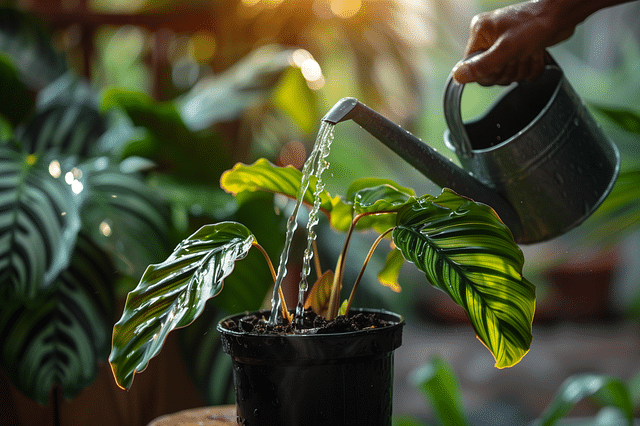
All Calatheas (not just the Ornata) are humidity lovers. So this is a great plant to have if you're generally a person who overwaters other plants. The Calathea Ornata can handle some overwatering. But there is a catch. When you're watering this plant, you should make sure to get rid of the excess water. You can do this in two ways:
- Plant the Calathea Ornata in the plastic nursery pot it came in and put that in the decorative pot. The nursery pot will have drainage holes and the excess moisture can escape.
- If you have a closed-off pot, tilt the plant sideways and let any excess water escape. This is a bit more tricky, but does work well for many moisture-loving plants.
These steps are important because while this plant loves to be moist, it doesn't like to sit in a puddle of water. This will cause root rot and that could kill the plant.
You should water this plant when the soil starts to dry out. This plant doesn't like to be in completely dry soil, so make sure to water it before it dries out too much. In the summer this means you should water this plant every week or every two weeks, depending on how dry the soil is. In the winter you can water this plant every two to four weeks, again, depending on how dry the soil is.
So to sum up the watering:
- Water plentiful, this plant loves to have moist soil at all times
- Let any of the excess water escape, this plant can't sit in a puddle
Water quality
Water quality is very important to keeping your Calathea Ornata healthy. It can be a fussy plant with dramatic reactions to water. This plant, like many others, can be sensitive to chemicals commonly found in tap water, such as chlorine and fluoride. These chemicals can cause damage to the leaves and can cause browning or yellowing at the tips and edges.
Chlorine can cause harm by breaking down cell structure, leading to wilting, while fluoride can interfere with photosynthesis, stunting the plant's growth. Also, high levels of salts, which can also be present in tap water, can build up in the soil, damaging the roots and preventing moisture absorption.
An easy solution is to use filtered or distilled water. Filtered water has had most of its impurities removed, and distilled water has been boiled into vapor and condensed back into liquid in a separate container, removing minerals and chemicals. Rainwater or melted snow can also be great natural options to water your Calathea.
If you only have access to tap water, you can still use it by letting it stand uncovered for 24 hours. This allows the chlorine to evaporate before you use the water with your plants. An added benefit of this method is that the water becomes room temperature and this helps to not shock your plant. One downside, this method doesn't remove fluoride, so if your tap water contains high levels of fluoride, you might still need to use distilled or filtered water.
Light requirements
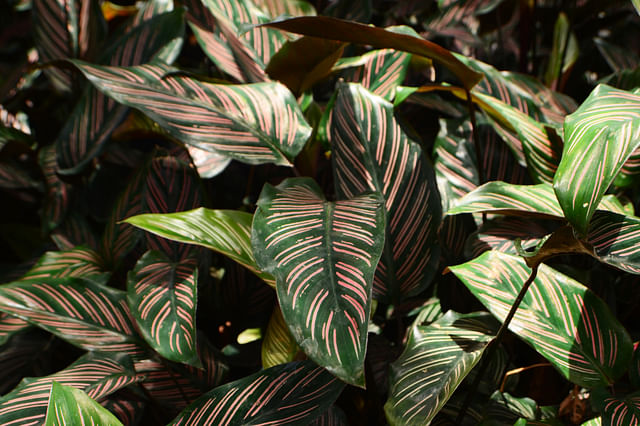
Calathea plants are tropical plants that grow on the ground under the shade of trees. This is their ideal sunlight exposure, so they should get low to medium sunlight throughout the day in your house. Keep them in a bright room with a thin curtain or some shade and you should be able to keep your plant happy.
My Calathea Ornata is close to a big south-facing window and gets medium/indirect sunlight for most of the day. When your Calathea gets exposed to direct sunlight, the sensitive leaves will start to fade and get sunburned.
So in summary keep your Calathea Ornata in a low to medium bright spot where it gets indirect sunlight.
Temperature
As we've discovered in the last section, the Calathea Ornata is a tropical plant. The ideal temperature range for this tropical plant is between 18 to 29 degrees Celsius (65 to 85 F). The Calathea will still survive if the temperature drops to 15 Celsius (60 Fahrenheit) but any lower and it'll start to harm the plant.
To keep your Calathea in these ideal conditions, avoid placing the plant in areas with cold drafts. This includes locations near windows or doors that might be opened from time to time, as this causes a sudden drop in temperature. Also, be careful with dry, hot drafts from heaters, which can dry out the environment too much and too quickly.
Consistency definitely is key when it comes to temperature conditions for the Calathea Ornata. Sudden temperature changes can stress the plant and lead to yellowing leaves.
Humidity
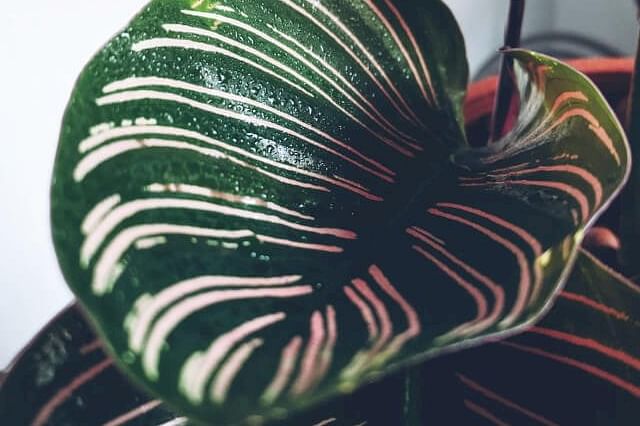
Together, we've learned that this Calathea is a tropical plant that loves to be in a moist environment. Calatheas love humidity and become prone to pests when their leaves are getting too dry.
To mimic the tropical environment in which this plant thrives, it needs a lot of humidity. Calathea prefers high humidity levels of 50% and higher. If you have a humidifier, keep it close by and make sure your Calathea is in a humid environment.
If you don't know how to raise the humidity, you can read my guide on 10 ways to raise the humidity in your house.
Soil for the Calathea Ornata
Being a tropical plant, Calathea loves to be in moist soil. This means that you should find soil that retains water for at least a few days. This way the plant can sit in moist soil for a longer time and you won't have to water it as often. If you don't have any soil that's made to retain water, that's not a problem. You'll just have to water the plant a little more often to keep the soil moist.
Because the soil needs to be moist most of the time, be sure to get soil that can breathe when it's moist. An ideal mixture for this type of soil would be 1/2 potting soil, 1/4 perlite, and 1/4 sphagnum moss.
If you were to use just potting soil, it becomes very dense and heavy when you keep it moist most of the time. This soil won't let any air go to the roots and this will slowly suffocate the plant. By adding the perlite and sphagnum moss, you're adding structure to keep the soil light and fluffy. This will let oxygen flow freely to your Calathea's roots, even when the soil is constantly moist.
Fertilizing your Calathea Ornata
Houseplants need a regular dose of fertilizer to stay healthy and look their best. The best time to fertilize is when the plant is actively growing, so for most plants that means fertilizing in the spring and summer. Fertilize your Calathea Ornata once every 14 days during this growing season.
Dilute the fertilizer according to the instructions on the package, then pour it over the soil around the plant. Don't pour it directly on the leaves, as this can cause them to burn.
When you use a liquid fertilizer, it's much easier to control the dose of the fertilizer, which helps to prevent over-fertilizing your Calathea. Over-fertilizing your Calathea could cause the roots to burn and this will slowly kill the plant. So make sure to follow the instructions that come with your liquid fertilizer.
In autumn and winter, you don't need to fertilize your Calathea at all. During these seasons your plant will be dormant and won't need as many nutrients. If you fertilize during winter, the nutrients can sit in the soil and cause it to become acidic, killing your Calathea.
Pruning and trimming
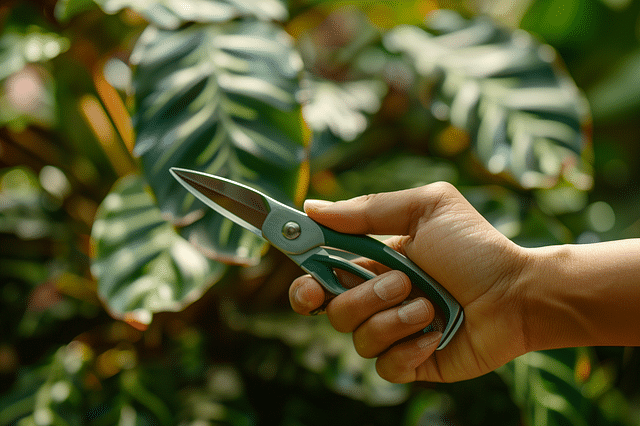
Pruning or trimming your Calathea Ornata not only helps maintain its shape but also encourages new growth by removing dead or dying foliage that can drain energy from the plant. Here is a short guide on when and how to prune your Calathea Ornata:
When to Prune
The best time to prune your Calathea Ornata is during its active growing season, which is typically in the spring and summer. However, if you notice dead, dying, or diseased leaves at any time of the year, it's best to remove them as soon as possible.
How to Prune
- You will need a pair of clean, sharp pruning shears or scissors. Cleaning your tools before use can help prevent the spread of disease.
- Look for leaves that are yellow, brown, or wilted. These are the leaves you should remove. Healthy leaves on a Calathea Ornata should be vibrant with distinct stripes.
- Cut the unhealthy leaf off at the base of the stem, being careful not to cut into the main part of the plant. If only part of a leaf is damaged, you can trim the leaf back to the healthy tissue.
- Don't leave the pruned leaves on the soil surface as they can attract pests or cause disease. Instead, dispose of them away from your other plants.
- After pruning, clean your tools to prevent spreading any (potential) pests or diseases to your other plants.
Remember, while pruning can help maintain your Calathea Ornata's appearance, the key to keeping it healthy is proper care: consistent watering (with filtered or distilled water), high humidity, and indirect light.
Repotting a Calathea
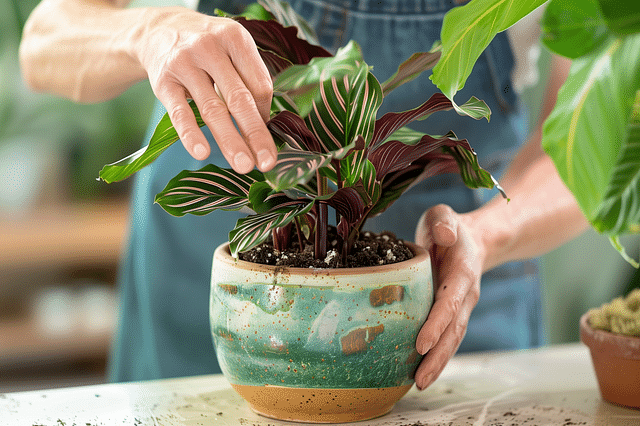
Repotting a Calathea Ornata regularly is important to make sure your plant keeps growing in the long term. Usually, you'll want to repot your plant every one to two years to provide the plant with fresh soil and a little extra space. When you notice the Calathea's growth is slowing down or its roots starting to peek out of the drainage holes, it's a sign that it's time for repotting.
The right pot size
When it comes to choosing the right pot size for your Calathea Ornata, look at the size of the root ball. The pot should be large enough to comfortably house the roots with a little extra space for growth, but not so big that the plant is drowning. A pot that is 2-3 inches larger in diameter than the current pot is a good choice.
The right pot material
In terms of material, both plastic and ceramic pots can work well. Plastic pots retain moisture longer, which is great for a moisture-loving plant like the Calathea Ornata. Ceramic pots, on the other hand, are heavier and provide stability for larger plants. They're also porous, which can help prevent overwatering because the excess water can easily evaporate.
When you do repot, try to do it in the spring or early summer, which is the plant's active growing season. This allows the plant to recover more quickly from the stress of being repotted.
Remember, repotting is also an excellent opportunity to inspect the roots for any signs of disease or pests. Healthy roots should be firm and white or light tan. If you see any dark, mushy, or smelly roots, these are signs of root rot and should be removed before repotting.
How to repot a Calathea
Let's take a look at how to repot the Calathea Ornata with a few simple steps.
Step 1: Get your supplies
You'll need a new pot that's 2-3 inches larger in diameter than the current one, a well-draining potting mix (1/2 potting soil, 1/4 perlite, 1/4 sphagnum moss), a pair of clean pruning shears, and a watering can.
Step 2: Remove the plant from the pot
First, water your Calathea Ornata thoroughly to moisten the root ball. This makes it easier to remove from the pot. Gently tilt the pot sideways, hold the plant at its base, and ease it out. If it's stuck, tap the sides of the pot to loosen the soil.
Step 3: Check the root health
Look at the roots for any signs of disease or pests. Healthy roots should be firm and white or light tan. If you see any dark, mushy, or smelly roots, use your pruning shears to remove them.
Step 4: Prepare the new pot
Cover the bottom of the new pot with a layer of your potting mix.
Step 5: Repot the plant
Place your Calathea Ornata in the new pot. The top of the root ball should be about an inch below the rim of the pot to allow room for watering. Fill in around the plant with more potting mix, pressing it down lightly to remove any air pockets.
Step 6: Water the plant
Water your repotted plant thoroughly, allowing excess water to drain out of the bottom of the pot. This helps the soil settle around the roots.
Step 7: Place the plant in the right spot
Finally, place your Calathea Ornata in a warm location with indirect light and high humidity. Avoid direct sunlight, which can scorch the leaves, and keep them away from cold drafts.
Remember to continue caring for your Calathea Ornata as usual after repotting, keeping the soil consistently moist but not waterlogged, and maintaining high humidity levels. It may take a few weeks for the plant to adjust to its new pot, so don't be alarmed if you see slower growth during this time.
How to propagate a Calathea Ornata
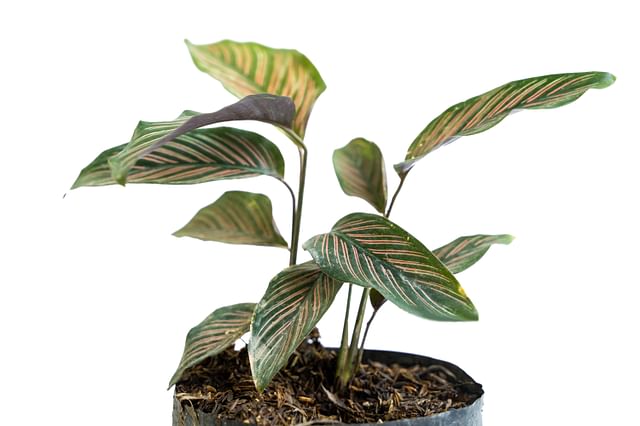
Unlike many other plants, you can't take cuttings of a Calathea Ornata to propagate your plant. If you want to propagate your Calathea, you'll need to divide your plant at the root level. What this means is that you'll need to separate your Calathea Ornata once it has started growing a new plant from its roots.
You'll know your Calathea Ornata has grown a new plant in the same pot when new stems are coming up from the soil away from any existing stems. This is different from new leaves on the same plant because new leaves grow from existing stems. Your plant can also grow new stems, which will always come out of the soil right beside any existing stems. Stems on the same plant will tend to stick together.
Steps to propagate a Calathea through division
Propagation through division means you'll separate multiple plants in the same pot and give each their own pot. This is the only successful method I've used to propagate this plant, so here's a step-by-step guide:
- Carefully remove the plant from its pot.
- Gently shake off excess soil and identify the natural divisions in the plant. These are usually quite obvious - look for multiple stems growing from the same root system.
- Using a clean, sharp knife or pair of scissors, cut the root ball into sections, ensuring each division has at least one stem (and preferably more).
- Repot each division into a new pot with fresh, well-draining potting mix.
- Water thoroughly and place the new plants in a warm, humid environment away from direct sunlight.
- Care for them as usual, keeping the soil consistently moist but not waterlogged.
Calathea Ornata can take several weeks to show signs of new growth after propagation because they're quite easy to shock. They'll need a few weeks to recover and focus on growing again.
Is Calathea toxic to pets?
A lot of houseplants can be harmful to pets and young children, but luckily Calatheas are not one of those plants. A Calathea, including the Calathea Ornata, is safe for pets and won't harm them when they chew your plant. Unlike many other plants, you can safely put this plant wherever you want to, without worrying about a doctor's visit.
Common pests
The Calathea Pinstripe is prone to a few pests, like spider mites. With some regular maintenance, you should be able to keep this under control though. A way to treat this pest is to clean the leaves with a mixture of water and dish soap in a spray bottle. You can use this on the leaves and this will suffocate the pests on and in the leaves. Afterward, you can wipe the leaves and you should be set for the next few weeks. You should repeat this process every one to two weeks, just to make sure it doesn't spread too much.
Early signs of trouble
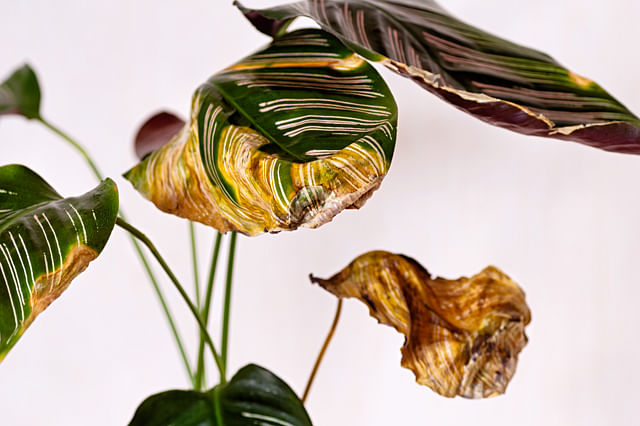
The Calathea Pinstripe can be a fussy plant. Luckily, there are many early warning signs that your Calathea isn't happy. These symptoms include brown and crispy leaves, leaves that start to turn yellow, and the pink stripes fading to a white color. When this happens, it doesn't mean your Calathea is dying. It simply means the Pinstripe plant isn't getting the care it wants.
Brown, crispy leaves
When the leaves start to get brown or yellow, they might be in an environment that's too dry for the plant. In this case, make sure to increase the humidity around your Calathea Ornata. You can do this by placing your plant on a pebble tray or using a humidifier.
Fading pink stripes
When the pink stripes on the leaves start to fade to white, the plant is getting too much sunlight. Move it to a place that's a little more shaded and you'll see the difference.
Yellow leaves
Yellowing leaves can be a sign of overwatering or poor water quality. Check the moisture level of your soil before watering. The top inch should be dry to the touch. Use distilled, rain, or filtered water instead of tap water, which can contain minerals that Calatheas don't like.
Curling leaves
Curling leaves are often a result of low humidity or under-watering. Increase humidity around your plant by placing it on a pebble tray filled with water, regularly misting it, or using a humidifier. Make sure you're not letting the soil dry out completely between waterings.
Drooping leaves
Drooping stems can mean overwatering, underwatering, or a need for repotting. If the soil is too wet, allow it to dry out a bit before watering again. If it's too dry, water your plant more frequently. If your plant has been in the same pot for a long time, it may be root-bound and need repotting.
Seasonal Care
The Calathea Ornata is a tropical plant that has different care needs throughout the year. Every season is different, so you'll need to adjust your care routine a little to accommodate this plant. Here's what you need to know:
Spring and Summer (Growing Season)
During these warmer months, the Calathea Ornata is in its active growth phase.
- Watering: Water your Calathea Ornata 1-2 times a week. Always test the soil before watering; it should be dry to the touch about an inch below the surface. Overwatering can lead to root rot.
- Light: Calathea Ornata prefers low to medium sunlight. Keep them in a bright room but out of direct sunlight, which can scorch their leaves.
- Fertilizing: Use a houseplant fertilizer once or twice a month during this period. Apply half the recommended amount to avoid over-fertilizing.
- Temperature: Keep your Calathea Ornata in a warm environment. They don't tolerate cold well, so protect them from drafts, open windows, air-conditioning units, and sudden temperature drops.
Autumn/Fall and Winter (Dormant Season)
In the cooler months, your Calathea Ornata will enter a dormant phase where growth slows down.
- Watering: Reduce watering during the winter months. The plant's water needs will decrease as growth slows, so monitor the soil carefully to avoid overwatering.
- Light: Continue to provide bright, indirect light.
- Fertilizing: Calatheas do not need to be fertilized during the winter months.
- Temperature: Continue to protect your Calathea Ornata from sudden temperature changes and drafts. Also, make sure to keep the plant away from any heating sources such as radiators.
Making these small adjustments throughout the year will help your Calathea Ornata stay healthy and vibrant in every season.
Similar Calatheas
There are a few Calatheas that have similar care needs as the Calathea Ornata. Below you'll find the Calatheas that I've personally tested with this plant care routine.
Calathea Triostar
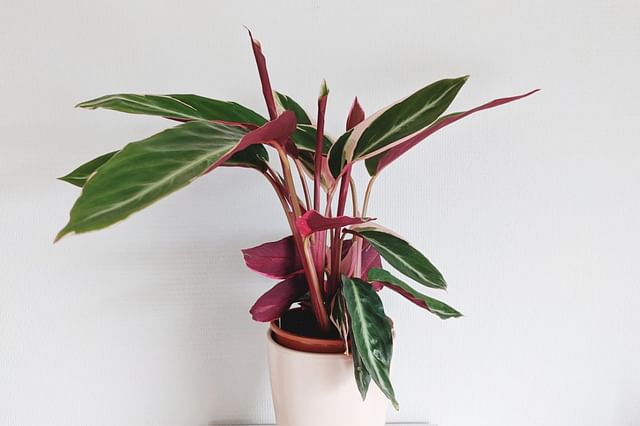
The Calathea Triostar is a Calathea that looks different than the Calathea Ornata, but it needs the same plant care routine.
It loves moist soil and needs a lot of humidity to be happy. Like the Calathea Ornata, it also grows its leaves rolled up. When the new leaves are big enough, they slowly unfold to show those large colorful leaves.
Conclusion
And that's all there is to it. The Calathea Ornata can be fussy, but once you stick to these guidelines you should be better prepared to take care of it. These care tips will at least help you to recognize signs and offer solutions to help you keep your Calathea healthy and help it thrive.
The most important things to keep in mind about this beautiful plant are these:
- Keep the soil moist.
- Keep the plant in a humid environment.
- Give the plant low to medium, indirect sunlight.
- Plant it in soil that retains water well, but allows air to get to the roots.
These are the most important suggestions. Now you're ready to get out there and get one of these amazing plants! I hope they give you as much joy as they've given me. Calatheas truly are beautiful and they can even be easy to take care of...once you apply the tricks from this guide.
Thank you for reading this post! I hope it helps you to keep your plants healthy and beautiful! If you're looking for more guides on specific plants, you can always request a plant guide to get a guide for the plant you have trouble with.
Test your plant care knowledge
Quiz completed!
Want to learn more? Sign up for my newsletter to receive free tips in your inbox!
Sign up now!